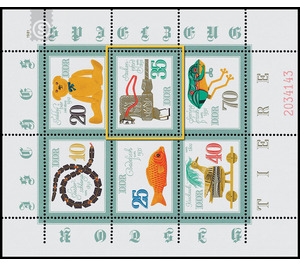Commemorative stamp series - Germany / German Democratic Republic 1981 - 35 Pfennig
Theme: Post & Philately
| Country | Germany / German Democratic Republic |
| Issue Date | 1981 |
| Face Value | 35.00 |
| Color | green |
| Perforation | K 13 1/2: 13 |
| Printing Type | offset |
| Stamp Type | Postage stamp |
| Item Type | Stamp |
| Chronological Issue Number | 2406 |
| Chronological Chapter | GER-DDR |
| SID | 260455 |
| In 12 Wishlists | |
Historical Toys - Animals With illustrations of historical toy animals, the Ministry of Posts and Telecommunications of the German Democratic Republic publishes six multicolored special postage stamps printed together on a miniature sheet. No special first day cover envelope Special cancellation from 24th November 1981 to 23rd January 1982 Historic toys - animals Play animals occupy an important place in the motif treasure of the toy today as ever, because their role models are an important part of our environment. They awaken and promote in the child the knowledge of the meaning of the animal for humans, whether as part of the surrounding nature, as a useful pet or as a comrade and playmate. The game animals selected for the special postage stamp issue may stand for this finding. Over a period of two hundred years, to which these testimonies belong, different materials and technical means have been used to design the characteristics of different animals and to develop manageable toys. The hobbyhorse should be a pretty old toy. From the Middle Ages, horses are made of burned clay, which have a hole on the bottom, which was certainly intended for attachment to a stick. Also pictorial representations are well-known, so a copper engraving of Jacob von Heyden from the year 1632, which shows among other children's games also a boy, who rides on a hobbyhorse. Our example (35 Pfennig value) shows a hobby horse carved and painted around 1850 in the Berchtesgadener Land, a form that was certainly created as early as the 18th century and is a testimony to the folk art of that time. This special postage stamp issue gives a small outline of the history of the toy since 1800 on the basis of six motifs and shows the change that has taken place in these two hundred years.


